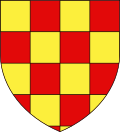Annonay
Annonay (French pronunciation: [anɔnɛ]; Occitan: Anonai) is a commune and largest city in the north of the Ardèche department in the Auvergne-Rhône-Alpes region of southeastern France.
[4] Annonay is a crossroads of trade routes: from the Rhône Valley to the region of Saint-Étienne (east-west) and from Lyon to south of the Massif Central (north-south).
[5] The geology consists mainly of grey or light orange leucogranite and orthogneiss rich in biotite, sillimanite, and cordierite with alternating bands of felsic and mafic material.
A chronicle of archives in Vienne characterized the city as a small town "built by poor unclothed workers lost in the mountains of Haut-Vivarais".
A manuscript which has now disappeared, History of Annonay by P. Bartholomew Popon stated that Evance, Bishop of Vienne, had built on the site of Liberty Square a church dedicated to Saint-Mary or Our Lady in 584.
During the 15th century, Annonay affirmed itself as a commercial crossroads: exporting its wine, trading between the valley of the Rhône, the Dauphiné and the mountain by mule, the tannery developed using the waters of the Deume.
The city, built on a rocky outcrop located between two rivers, was defended by the castle of Roussillon in the south and two fortified houses: in the north Maleton and in the west Du Peloux.
At the end of the 16th century thirty tanneries were located on the banks of the Deume and Cance, attracted by the quality of their waters and the prosperous farms nearby.
The reconstruction of the city was characterized by the arrival of new religious communities and the creation of educational institutions such as the Convent of Santa Maria.
[10] The paper industry was started in Annonay in the 17th century with the Montgolfier brothers, papermakers originating from Auvergne, installed at Vidalon-lès-Annonay (today a hamlet in the commune of Davézieux).
Attracted to the water quality, the driving force of the rivers, and the abundance of raw materials (rags), they imported technological innovations from Holland: e.g. the Dutch pile.
[citation needed] In the maze of streets and small squares of Annonay, there was progress with the commissioning in 1726 of four public fountains fed by captive water sources.
This success did not go smoothly: the employment in great numbers of the best workers by Montgolfier caused a scarcity of labor and demands for wage increases.
There was a strike for two months in the Vidalon Workshop in late 1781 after a long period of tension between the employer and his employees, the first lost the best of his workforce through his intransigent attitude[11] at a time when fights between gavots and journeymen were common.
The Terror made victims such as Pierre-François Dulau-Dallemand, the pastor of Saint-Julien-Vocance; Bartholomew Montblanc, Vicar at Givors hidden around Annonay, and the priests of Rouville, Bac-et-Guards, and former Jesuits.
During the first half of the 19th century, the need for an industrial workforce for paper-making and leather at Annonay attracted population from the surrounding countryside.
The physiognomy of the city changed with the rapid development or opening of new shopping streets (Rues Sadi Carnot, Montgolfier, Boissy d'Anglas, Tournon, Melchior de Vogue).
[14] With demographic pressure, the size of the existing infrastructure including the sole Catholic church did not allow proper welcoming of new residents to the faith.
Around the city, about a kilometer or two new town houses were built in the image of the Domain of Marc Seguin or Déomas Castle constituting a "sunbelt".
Improving the road network and creating the first lines of railway put an end to Annonay's role as a commercial center for the mountainous hinterland.
While modern community life was started with the creation of the first sports clubs such as Annonéenne, a company gym which still exists; the nascent local press reported on events such as celebrations marking the centenary of the first flight of a balloon.
Annonay improved its main entrance by creating a new road connecting the PLM station to the center of town: the Boulevard of the Republic (1883–1888).
There were expulsions of monks and nuns with the Querelle des inventaires particularly active during violent protests motivated by the fear of a return to the excesses of 1793–1794.
The period between the two wars was marked by the presidential visit of Alexandre Millerand in 1923 on the occasion of the inauguration of the monument in honor of Marc Seguin and by the 150th anniversary of the first flight of the balloon (1933).
The old craft business of Jean-Joseph Besset became Renault then Irisbus, who manufacture its entire range of buses and coaches for France.
The Annonay people celebrated with great pomp the centenary of the railway line (1970), Marc Seguin (1975 and 1986), and the bicentennial of the first flight of the hot air balloon (1983).
The people of Annonay celebrated the centennial of the opening of the new Church of Notre Dame (2012) and the establishment of the Joseph Besset factory (2013).
[4] A modern dam was constructed across the Ternay, an affluent of the Deûme northwest of town, which expanded the power available to local factories.
[19] By the First World War, the leather industry had become predominant, while the economy expanded to include more raw silk, flour, chemical manures, glue, gelatine, brushes, chocolates, and candles.
Irisbus (a Renault Vehicles Industries and Fiat Iveco joint venture) builds buses and is the largest single employer with around 2,000 staff with several associated businesses.













